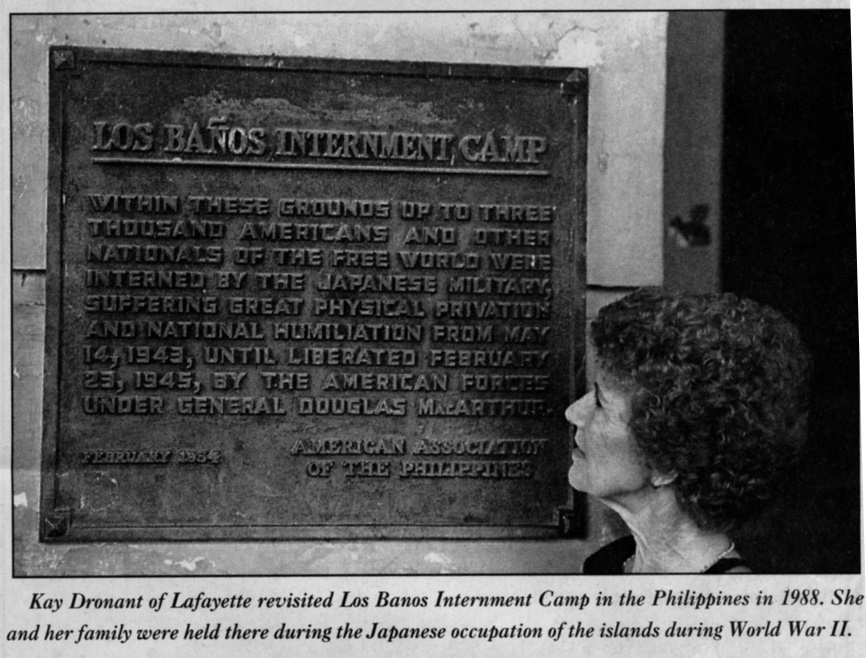The Most Exciting
Day of My Life
From the Lafayette LA Dailey Advertiser
February 23, 1995
February
23, 1945 (50 years earlier)
LIBERATION
FROM JAPANESE INTERMENT
By
Kay Drouant
About the writer
Kay Drouant, the former
Kathryn Elizabeth Gilfoil, lived in the Philippines with her parents, William
and Katherine, and three younger sisters beginning in 1938, and spent three
years, from early January 1942 to February 23, 1945 — under Japanese occupation.
She was at Santo Tomas and the Holy Ghost Convent in
Manila and at Los Banos, the agricultural university of the Philippines. Today
she is married to Lou Drouant and lives in Lafayette.
They have six children and 15 grandchildren.
Madison
Coordinator’s Note: After leaving the Philippines, Betty Kaye came to Madison
Parish to live with her grandparents - the W. R. Gilfoils.
She graduated from Tallulah High School (with me) in 1948. None of this was
mentioned in the newspaper article which misspelled her last name (Dronant for Drouant) and her
husband’s first name (Lon for Lou.) This has been corrected in the article.
Betty Kaye passed away in 2005. For more on Betty Kaye’s World War II prison
camp experiences click here.
RPS October 2016

It was probably
a good five minutes before 7 a.m. morning roll call at Los Banos Internment
Camp on February 23, 1945. A few of us, mostly kids, were already out in front
of the barracks waiting, when from the north there appeared nine huge transport
planes. As they drew just to the east of us, the bright morning sky was
suddenly ablaze with approximately 150 paratroopers floating earthward.
Thus began the
most exciting day of my life.
As watching
American planes had been a “no-no" for several months we reluctantly
turned to leave. Shots rang out from several directions — and our reluctancy changed to an urgent dash for cover.
Along the sides
of the 200-by30-foot barracks were drainage ditches three to four feet deep.
They were our salvation. For about 20 minutes bullets whizzed overhead. Mom and
Dad had quite a job keep for excited little girls down.
The paratroopers
had been joined by amphibious tank crewmen and Filipino guerrillas from the
surrounding hills. About 200 Japanese soldiers had come to the aid of our 47
guards.
When the battle quieted down, the
ditch could contain us no longer. We darted through the barracks and into the
center hallway, entrance
by the most beautiful man — a muddy, sweaty Yank who asked, “Any Japs in here?'
Soon American
soldiers poured into all the barracks. We were told very calmly, but precisely,
to gather any valuables we might have left, but no clothing other than what we
were wearing, and to hurry down to the exercise field for evacuation. Right
now. They were very calm, never letting on to the grave danger that we were
in.
Mom searched in
vain for her diamond pin. Dan urged her to forget it. There was really nothing
more valuable than getting away from there and to freedom. My 12-year-old
sister left without us. Mom and Dan, my other two sisters, who were 9 and 3,
and 1, a very mature 14, stayed together.
At the field we were loaded into
amphibious tanks, which headed toward Laguana de Bay,
two miles away, then 25 miles across the lake to the town of Cubio. In Cubio, we were loaded
onto trucks which took us to Montinlapa, where New Bilibid Prison is located. The tanks which had roared
ashore early that morning could not carry everyone at once. Many walked to the
lakeshore from Los Banos and waited there for the tanks to cross and return for
the second load.
Looking behind
them, they saw the bamboo barracks going up in flames. A few Japanese snipers
tried to get some of us along the way, but our gunners took care of them.
It was a long,
tiring and eventful day when the last of us reached New Bilibid,
close to 5 p.m. Only then were we told the reason for the spectacular piece of
rescue work.
After the
slaughter of Americans and U.S. allies in Manila, our Army felt that we might
be treated likewise. There were several thousand Japanese in the mountains west
of us — this was the reason for haste. Our troops that day had rescued over
2,000 internees from a hornets' nest. They fed us vegetable soup straight from
the can (no water added) and crackers and put us to bed in a Philippine prison
over which we saw the Stars and Stripes of America.